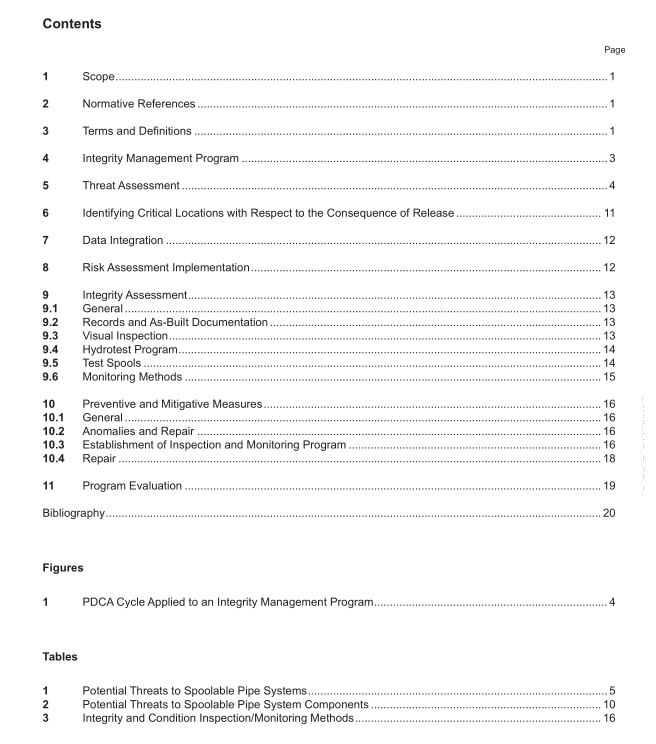API RP 15SA pdf download

API RP 15SA pdf download Integrity Management of Spoolable Reinforced Line Pipe
1Scope
This recommended practice is for integrity management of an existingAP115S asset including threat identification,identification of potential failure modes, risk assessment, testing requirements,initial and ongoing inspectionpractices, end-fitting and coupling inspection, potential mitigations, repair, and associated documentation.
2Normative References
The following referenced documents are indispensable for the application of this document.For dated references,only the edition cited applies. For undated references, the latest edition of the referenced document (includedany amendments) applies.
API Specification 15s, Spoolable Reinforced Plastic Line Pipe
APIRecommend Practice 15SIH, Installation and Handling of Spoolable Reinforced Line Pipe3Terms and Definitions
For the purposes of this document, the following terms and definitions apply.3.1
blistering
Damage in the form of gas-illed pockets caused by the release of absorbed gas on depressurization within asolid polymer layer (e.g- polymeric liner).
3.2
brittle failure
Acomponent failure mode which exhibits no visible (to the naked eye)permanent material deformation (stretching.elongation, or necking down) in the area of the break.
3.3
connector
Device used to provide a leak-tight (except to intentionally vent gas) structural connection between the end-fitingand adjacent piping (e.g. bolted flanges, clamped hubs, weld necks, and proprietary connectors).
3.4
coupling
fitting developed for joining one section of pipe to another (e.g. in-line connector).
3.5
coupon
test piece cut from a representative specimen.
3.6
cover
Protective outer sheath of the pipe.
3.7
cyclic loading
More than 7000 pressure cycles and △PINPR >6 % where △P is maximum to minimum amplitude.
3.8
end-ftting
A mechanical device that forms the transition from the pipe to the connector.
3.9
feld-ftting
End-ftting or coupling designed for permanent installation.
3.10
liner
Continuous polymeric layer that is in contact with the conveyed fuid.
3.11
liner collapse
Movement of the liner away from the structural layer on reduction of internal pressure.
3.12
maximum operating pressure (MOP)
The maximum pressure permitted for normal pipeline operation. It is obtained by multiplying the NPR by
application related service factors.
3.13
maximum pressure rating (MPR)
The maximum internal hydrostatic pressure that can be applied continuously to a pipe with a high degree of certainty that failure of the component will not occur.
3.14
nominal pressure rating (NPR)
Pressure rating of the pipe as defned by the manufacturer and does not exceed the maximum pressure rating (MPR).
3.15
operating minimum bend radius (MBR)
Minimum allowable bend radius for the installed and pressurized pipe.
3.16
purchaser’s agent
An installation contractor, inspector, or manufacturer hired by the purchaser to perform specifc tasks (e.g. storing unspooling, joining, handling, inspecting).
3.17
road crossing
A design feature in pipeline construction that accounts for the placement of a spoolable reinforced line pipe across a road such that vehicular trafc can pass over the pipe without damage to the pipe or vehicle.
3.18
rupture
A tear, break, or fracture.
3.19
service life
Period of time during which the pipe fulflls all performance requirements.
3.20
spoolable pipe
Pipe that can be provided as a coil or on a structural reel for transportation.









